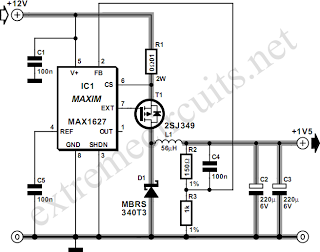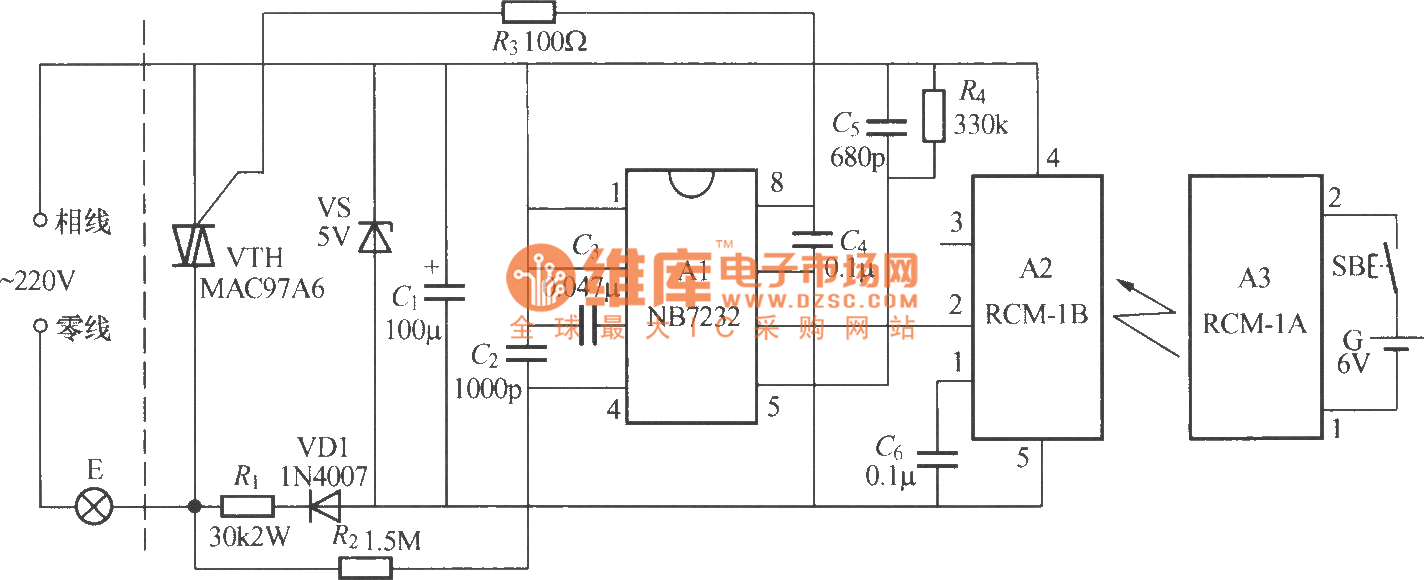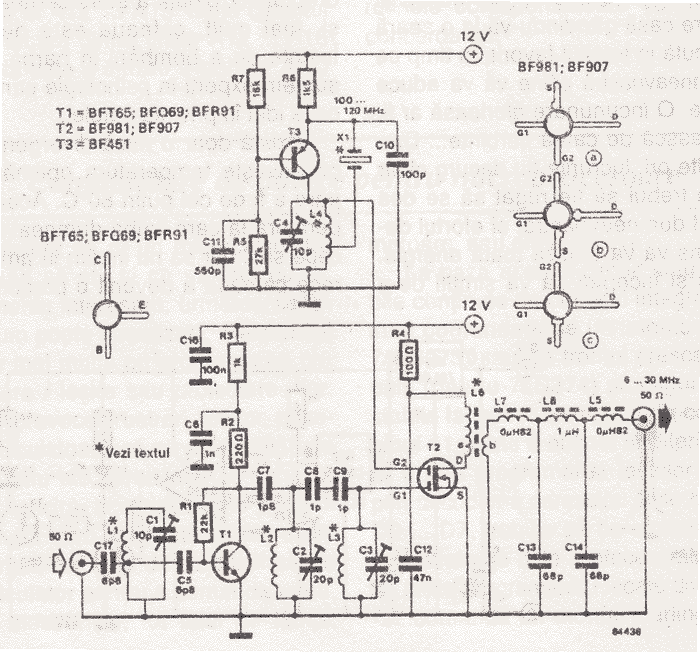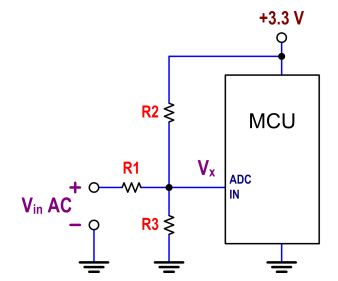
Radio Beacon Converter
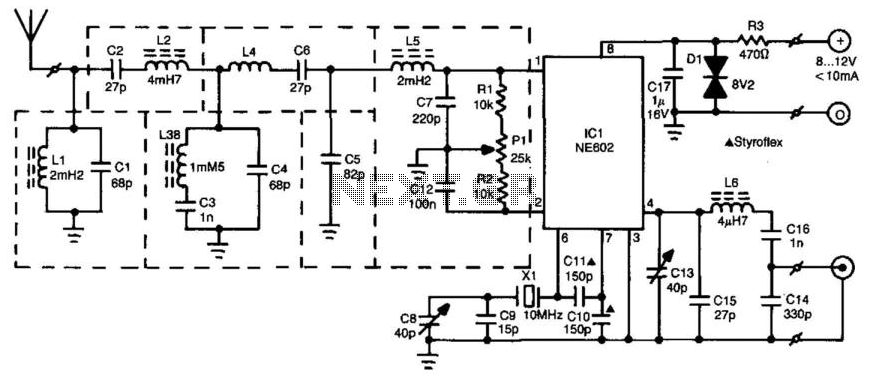
The radio beacon band ranges from 280 to 516 kHz. Each beacon transmits a unique AM-modulated Morse-coded callsign on a designated frequency. To receive distant beacons, the aerial signal is processed through a band-pass filter that effectively attenuates longwave and mediumwave signals. This filter also transforms the aerial impedance, Zm, from approximately 10 kΩ to the input impedance of mixer IC1, which is around 1 kΩ. The mixer combines the received signal with the local oscillator signal, allowing the beacon signal to be captured by a standard shortwave receiver. The output frequencies generated range from 9.72 to 9.48 MHz or from 10.280 to 10.516 MHz. During the construction of the converter, certain components must be enclosed in a metal shield, as indicated by dashed lines on the PCB layout. The circuit is calibrated using an SSB receiver, to which the converter's output is connected. The receiver should be tuned to 10 MHz, and the oscillator frequency of the converter should be adjusted using C8 for zero beat. Following this, the receiver should be slightly detuned until a pleasant whistle is heard, which is minimized using PI. Finally, the receiver should be set to a beacon transmitting around 300 kHz, adjusting C13 for optimal sound output.
The radio beacon system operates within a specified frequency range, facilitating the transmission of Morse-coded callsigns for identification purposes. The band-pass filter serves a dual role: it not only filters out unwanted signals but also matches the impedance levels between the aerial and the mixer IC1, ensuring efficient signal processing. The mixer circuit is crucial as it shifts the frequency of the incoming beacon signal to a range compatible with standard shortwave receivers. This frequency conversion is essential for practical reception, as the original beacon frequencies are not directly accessible by typical shortwave equipment.
The design of the circuit includes specific considerations for shielding sensitive components, which is vital for minimizing electromagnetic interference and ensuring stable operation. The alignment process is critical for achieving optimal performance. By utilizing an SSB receiver, the user can fine-tune the oscillator frequency to achieve a zero beat condition, which indicates that the local oscillator and the incoming signal are in phase, maximizing the signal strength. The subsequent detuning process allows for the identification of the beacon signal, which can be adjusted for clarity and volume, ensuring that the output is not only audible but also of high quality.
In summary, this radio beacon receiver circuit exemplifies a well-engineered solution for receiving and decoding Morse-coded signals from distant beacons, incorporating essential filtering, impedance matching, and alignment techniques to enhance performance and usability within the designated frequency range. The radio beacon band extends from 280 to 516 kHz. Each beacon has its own characteristic AM"-modulated morse-coded callsign that is transmitted on a specific frequency. To be able to receive distant beacons, the aerial signal is passed through a band-pass filter that effectively suppresses longwave and mediumwave signals. The filter also converts the aerial impedance, Zm, from about 10 KOhmhm to the input impedance of mixer IC1, which is about 1 KOhmhm.
The mixer adds or subtracts the received signal to/from the local oscillator signal so that the beacon signal can be received on a normal shortwave receiver. The resulting frequencies are from 9.72 to 9.48 MHz or from 10.280 to 10.516 MHz. In the construction of the converter, some components must be surrounded by a metal shield, as indicated by dashed lines on the PC board layout.
The circuit is aligned with the aid of an SSB receiver, to which the output of the converter is connected. Tune the receiver to 10 MHz and adjust the oscillator frequency of the converter with C8 for zero beat.
Next, detune the receiver slightly until you hear a pleasant whistle, which is adjusted for minimum level with the aid of PI. Finally, tune to a beacon transmitting at or about 300 kHz and adjust C13 for maximum sound output. 🔗 External reference
The radio beacon system operates within a specified frequency range, facilitating the transmission of Morse-coded callsigns for identification purposes. The band-pass filter serves a dual role: it not only filters out unwanted signals but also matches the impedance levels between the aerial and the mixer IC1, ensuring efficient signal processing. The mixer circuit is crucial as it shifts the frequency of the incoming beacon signal to a range compatible with standard shortwave receivers. This frequency conversion is essential for practical reception, as the original beacon frequencies are not directly accessible by typical shortwave equipment.
The design of the circuit includes specific considerations for shielding sensitive components, which is vital for minimizing electromagnetic interference and ensuring stable operation. The alignment process is critical for achieving optimal performance. By utilizing an SSB receiver, the user can fine-tune the oscillator frequency to achieve a zero beat condition, which indicates that the local oscillator and the incoming signal are in phase, maximizing the signal strength. The subsequent detuning process allows for the identification of the beacon signal, which can be adjusted for clarity and volume, ensuring that the output is not only audible but also of high quality.
In summary, this radio beacon receiver circuit exemplifies a well-engineered solution for receiving and decoding Morse-coded signals from distant beacons, incorporating essential filtering, impedance matching, and alignment techniques to enhance performance and usability within the designated frequency range. The radio beacon band extends from 280 to 516 kHz. Each beacon has its own characteristic AM"-modulated morse-coded callsign that is transmitted on a specific frequency. To be able to receive distant beacons, the aerial signal is passed through a band-pass filter that effectively suppresses longwave and mediumwave signals. The filter also converts the aerial impedance, Zm, from about 10 KOhmhm to the input impedance of mixer IC1, which is about 1 KOhmhm.
The mixer adds or subtracts the received signal to/from the local oscillator signal so that the beacon signal can be received on a normal shortwave receiver. The resulting frequencies are from 9.72 to 9.48 MHz or from 10.280 to 10.516 MHz. In the construction of the converter, some components must be surrounded by a metal shield, as indicated by dashed lines on the PC board layout.
The circuit is aligned with the aid of an SSB receiver, to which the output of the converter is connected. Tune the receiver to 10 MHz and adjust the oscillator frequency of the converter with C8 for zero beat.
Next, detune the receiver slightly until you hear a pleasant whistle, which is adjusted for minimum level with the aid of PI. Finally, tune to a beacon transmitting at or about 300 kHz and adjust C13 for maximum sound output. 🔗 External reference
